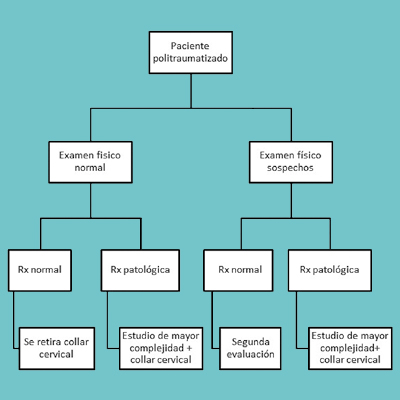Evaluation of cervical spine injuries in polytraumatized patients in Emergency Service
Main Article Content
Abstract
Materials and Methods: This is a cross-sectional and observational study to determine the sensitivity and specificity of the clinical examination for the diagnosis of cervical spine injuries, comparing imaging studies over a 22-month period in an emergency unit.
Results: During this period, 127 patients were assisted. In 101 patients, the neurological and physical examination was normal. No injuries were recorded when performing radiographs or CT scans on these patients. During examination, 26 patients felt pain after palpation of the spinous processes. After a CT scan, 6 of these patients were found to have a cervical spine injury. The sensitivity of the physical examination was 100% and the specificity was 83%. The false positive rate was 17% and no false negatives were recorded.
Conclusions: The data from this study shows that the majority of studies by imaging, radiographs or CT scans could be reduced, without losing the sensitivity of cervical spine injuries diagnoses, and thus reducing the costs of care.Level of Evidence: IV
Downloads
Metrics
Article Details
Manuscript acceptance by the Journal implies the simultaneous non-submission to any other journal or publishing house. The RAAOT is under the Licencia Creative Commnos Atribución-NoComercial-Compartir Obras Derivadas Igual 4.0 Internacional (CC-BY-NC.SA 4.0) (http://creativecommons.org/licences/by-nc-sa/4.0/deed.es). Articles can be shared, copied, distributed, modified, altered, transformed into a derivative work, executed and publicly communicated, provided a) the authors and the original publication (Journal, Publisher and URL) are mentioned, b) they are not used for commercial purposes, c) the same terms of the license are maintained.
In the event that the manuscript is approved for its next publication, the authors retain the copyright and will assign to the journal the rights of publication, edition, reproduction, distribution, exhibition and communication at a national and international level in the different databases. data, repositories and portals.
It is hereby stated that the mentioned manuscript has not been published and that it is not being printed in any other national or foreign journal.
The authors hereby accept the necessary modifications, suggested by the reviewers, in order to adapt the manuscript to the style and publication rules of this Journal.
References
2. Stiell IG, Clement CM, McKnight RD, Brison R, Schull MJ, Rowe B, et al. The Canadian C-spine rule versus the
NEXUS low-risk criteria in patients with trauma. N Engl J Med 2003;349(26):2510-8. https://doi.org/10.1056/
NEJMoa031375
3. Michaleff ZA, Maher CG, Verhagen AP, Rebbeck T, Lin CW. Accuracy of the Canadian C-spine rule and NEXUS to
screen for clinically important cervical spine injury in patients following blunt trauma: a systematic review. CMAJ
2012;184(16):E867-E876. https://doi.org/10.1503/cmaj.120675
4. Stiell IG, Wells GA, Vandemheen KL, Clement CM, Lesiuk H, De Maio VJ, et al. The Canadian C-spine
rule for radiography in alert and stable trauma patients. JAMA 2001;286(15):1841-8. https://doi.org/10.1001/
jama.286.15.1841
5. Stiell IG, Clement CM, Lowe M, Sheehan C, Miller J, Armstrong S, et al. A multicenter program to implement the
Canadian C-Spine rule by emergency department triage nurses. Ann Emerg Med 2018;72(4):333-41. https://doi.
org/10.1016/j.annemergmed.2018.03.033
6. Rose MK, Rosal LM, Gonzalez RP, Rostas JW, Baker JA, Simmons JD, et al. Clinical clearance of the cervical spine in patients with distracting injuries: It is time to dispel the myth. J Trauma Acute Care Surg 2012;73(2):498-502. https://doi.org/10.1097/ta.0b013e3182587634
7. Paykin G, O’Reilly G, Ackland HM, Mitra B. The NEXUS criteria are insufficient to exclude cervical spine
fractures in older blunt trauma patients. Injury 2017;48(5):1020-4. https://doi.org/10.1016/j.injury.2017.02.013
8. Vaillancourt C, Stiell IG, Beaudoin T, Maloney J, Anton AR, Bradford P, et al. The out-of-hospital validation of the Canadian C-Spine Rule by paramedics. Ann Emerg Med 2009;54(5):663-71.e1. https://doi.org/10.1016/j.annemergmed.2009.03.008
9. Coffey F, Hewitt S, Stiell I, Howarth N, Miller P, Clement C, et al. Validation of the Canadian c-spine rule in the UK emergency department setting. Emerg Med J 2011;28(10):873-6. https://doi.org/10.1136/emj.2009.089508
10. Duane TM, Wilson SP, Mayglothling J, Wolfe LG, Aboutanos MB, Whelan JF, et al. Canadian Cervical Spine rule
compared with computed tomography: a prospective analysis. J Trauma 2011;71(2):352-7. https://doi.org/10.1097/TA.0b013e318220a98c
11. Moser N, Lemeunier N, Southerst D, Shearer H, Murnaghan K, Sutton D, et al. Validity and reliability of clinical prediction rules used to screen for cervical spine injury in alert low-risk patients with blunt trauma to the neck: part 2. A systematic review from the Cervical Assessment and Diagnosis Research Evaluation (CADRE) Collaboration. Eur Spine J 2018;27(6):1219-33. https://doi.org/10.1007/s00586-017-5301-6
12. Rethnam U, Yesupalan R, Gandham G. Does applying the Canadian Cervical Spine rule reduce cervical spine
radiography rates in alert patients with blunt trauma to the neck? A retrospective analysis. BMC Med Imaging
2008;8:12. https://doi.org/10.1186/1471-2342-8-12
13. Ecker TM, Kleinschmidt M, Martinolli L, Zimmermann H, Exadaktylos AK. Clinical presentation of a traumatic
cervical spine disc rupture in alpine sports: a case report. Scand J Trauma Resusc Emerg Med 2008;16:14. https://
doi.org/10.1186/1757-7241-16-14

